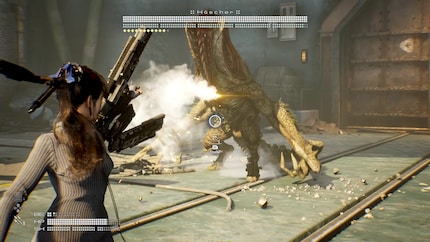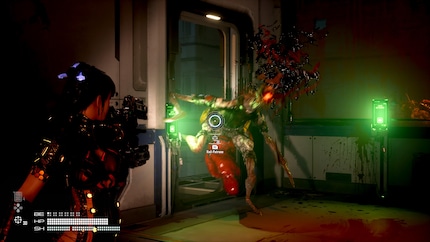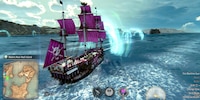

Stellar Blade review: a brilliant, action-packed fireworks display in a unique sci-fi setting
The small Korean studio Shift Up has achieved a huge success with Stellar Blade. Previously known for mobile games, the company has delivered a brilliant, action-packed fireworks display that can go toe-to-toe with the biggest and most expensive AAA games.
I only have a few life points left. This is going to be so close. My opponent starts to attack and runs towards me. It’s a hideous, giant monster with a rotating chainsaw for a head. I manage to block the attack with perfect timing and wrong-foot the beast. This is my chance. I run towards it and ram my sword into its back, splitting its body in two. My pulse is racing, my hands are sweaty. I did it.
Nerve-wracking fights like this are commonplace in Stellar Blade. With scantily clad superhuman protagonist Eve, I slaughter my way through hordes of alien monsters with stylish moves. Thanks to numerous sources of inspiration, the spectacularly staged PS5 exclusive game has much more to offer than just violence and bare skin.
An aesthetic sci-fi world with a melancholic vibe
I love the sci-fi world Shift Up has created in Stellar Blade. The game creates a unique, melancholic vibe and I find the vast stylistic contrasts fascinating.
In the distant future, humanity – or what’s left of it – no longer lives on Earth. Instead, the remnants of human civilisation have settled in a space colony. The reason: man-eating monsters called Naytibas that have spread across the planet. A small portion of humanity has been left behind, holed up in Earth’s last remaining city, Xion.

Source: Domagoj Belancic
Protagonist Eve is sent to Earth by the colony as part of an army of superhuman warriors. Her mission: free the blue planet from the monstrous invasion.
Eve is accompanied on her journey through the post-apocalyptic world by Adam and Lily, two residents of Xion. The dialogues and interactions between the three protagonists are sometimes a bit wooden and feel forced. The story didn’t blow me away either, apart from a few plot twists. That doesn’t bother me, though. Stellar Blade’s strength isn’t storytelling; it’s world-building.

Source: Shift Up
The closest comparison to the desolate sci-fi world of Stellar Blade is cult hit Nier: Automata. Here too, a scantily clad protagonist – armed with a sword and accompanied by a drone – roams a post-apocalyptic sci-fi world where she encounters multiple absurd opponents. The world of Stellar Blade is a step up from Nier: Automata in terms of aesthetics and atmosphere.
The game takes me through scorching hot deserts, the dilapidated remains of a former mega city and narrow corridors of underground bunkers that are filled with horrors. Despite the wide range of environments, the world in Stellar Blade appears to be made up of parts of the same whole. As I explore, I feel a melancholic mood. The game environments look hopeless and beautiful at the same time. Technically, the game impresses with detail-rich levels, excellent lighting and long-range views. A few blurry textures here and there don’t have a lasting effect on the excellent overall appearance.

Source: Domagoj Belancic
I’m always surprised by the creative and unusual settings the game presents me with. The game environments are bursting with atmosphere and history. I learn something more about the world at every turn. Sometimes through memories of fallen soldiers stored on memory sticks; sometimes through casual conversations with Adam and Lily, who accompany me via remote-controlled drone.
Beautiful people and ugly monsters
In keeping with the aesthetically pleasing game environments, the game also impresses with beautiful character models that look like a blend of different sources of inspiration.
The three protagonists – Eve, Adam and Lily – look flawless and could all be hired as anime supermodels. No wonder, because Eve’s look is based on real Korean model Shin Jae-eun. The residents of Xion are also visually exciting and remind me of characters from Borderlands or the Cyberpunk 2077 universe. Many of them look like cyborgs and have multiple machine modifications on their bodies.
The small details are particularly impressive. In close-up views, I see imperfections on the skin, tiny hairs and realistic metallic textures.

Source: Domagoj Belancic
As the game progresses, I continually unlock new costumes for Eve, which are usually skin-tight or show a lot of bare skin. I’m often reminded of Nintendo’s witch Bayonetta – though game director Hyung-Tae Kim cites the Gamecube classic P.N.03 as a source of inspiration for Eve’s character design.
Stellar Blade goes a few steps further than those two games in terms of the overly sexualized portrayal of the main character. In the run-up to the release, her provocative outfits caused a lot of discussion. The latent eroticism in the gameplay and in dialogues with NPCs is a question of taste. I find some of the ultra-skimpy costumes and the noticeable jiggling of Eve’s body parts a bit too in-your-face. But it didn’t bother me too much. Among other things, because Eve’s suggestive behaviour fulfils an intriguing function in the game’s visual design.

Source: Domagoj Belancic
The attractive depiction of Eve’s body creates an interesting contrast to the incredibly grotesque Naytiba monsters that I slaughter in Stellar Blade. The ugly creatures are reminiscent of the Demogorgon from Stranger Things with their pale skin and red innards. They seem like foreign characters in the ultra-aesthetic world of Stellar Blade.
The Naytibas come in many forms. Sometimes I fight against decaying zombie creatures, sometimes against huge, mutated insects or ugly tentacle monsters with thousands of teeth. When Eve turns one of them into mud in her skin-tight outfit in front of a beautiful backdrop, these contradictory elements merge into a harmonious overall picture.

Source: Shift Up
Soulslike-inspired combat system
The combat system in Stellar Blade is inspired by Soulslike games. I slash enemies with Eve’s glowing sword, using either fast and weak attacks or slow and strong attacks. I either have to counter enemy attacks with my sword or dodge them. With perfect defensive timing, I replenish energy for devastating special attacks. I don’t have to worry about Eve’s stamina compared to many other Soulslikes – I can run around and dodge as long as I want. Nevertheless, caution is needed in combat. If I block an attack too late or too early, my shield is affected and I leave myself vulnerable.
As the game progresses, I unlock a temporary "Battle Mode", which I activate by clicking on the two analogue sticks. Similar to Kratos with the Spartan Rage mode in God of War, Eve mutates into an all-destroying super warrior for a few seconds. Cool! The Soulslike combat system is rounded off with ranged weapons. Overall, these are a bit too powerful. If I have enough ammunition, I can easily shoot myself to victory against strong boss opponents. But it’s always fun.

Source: Domagoj Belancic
Eve’s abilities can be expanded through multiple skill trees and modification slots for her combat armour. I’m motivated to unlock the skills because they give me a noticeable advantage in combat. The game offers a tough level of difficulty and an optional «story mode» that slows down and simplifies the combat. But even on the normal difficulty level, most players – with the exception of the ultra-difficult last level – shouldn’t have any major problems with Stellar Blade.
Overall, the combat system is very well executed. Stellar Blade hasn’t reinvented the wheel. Instead, it uses systems from well-known greats of the genre and fuses them together to create its own version. I’m particularly impressed by the spectacularly staged boss fights. But even after what feels like the thousandth time, slaughtering smaller Naytibas is still fun.

Source: Domagoj Belancic
Stellar Blade mutates into a wild mix of genres
The level design in Stellar Blade also uses ideas from other games. I spend most of my playing time in relatively linear but excitingly designed levels where there’s a lot to discover. Hidden areas with exciting lore information, rare items and collectible items motivate me to thoroughly examine every square millimetre. A handy scanning function on Adam’s remote-controlled drone helps me explore the surroundings.
There are also campfires scattered throughout the levels where I can relax and refill my inventory, namely potions and ammunition. As is typical in Soulslike games, all enemies in the level respawn once I activate a campfire. The camps also serve as checkpoints where I start a new attempt after I lose a life.

Source: Domagoj Belancicv
In addition to these Soulslike level sections, Stellar Blade continues to surprise me with completely unexpected gameplay situations in my 22 hours of playing time. In some levels, I have to do without my sword and fight my way through dark corridors full of ugly zombie Naytibas armed with my rail gun – Dead Space, is that you? Other sections of the game remind me of the best scenes from the Uncharted games with climbing elements and collapsing buildings.

Source: Domagoj Belancic
The game usually manages these detours into foreign genres quite well. Although some frustrating skill passages – where I have to master challenging platform courses with imprecise hopping controls – were less successful. I also find the two larger, open areas that Eve explores on her adventure to be rather dull. Although there are some exciting secrets to discover there, overall, the expansive game worlds feel empty and unnecessarily large.
Most of the side quests that I can take on in Xion are also just moderately intriguing. They often lead me to the two open game areas and follow the formula: go to location X and bring me back item Y. It’s a shame, as more could have been made of this.
The music. Oh my god, the music!
I’m reserving special praise for the game’s soundtrack, which is somewhere between K-pop and electro. Here too, there are parallels to Nier: Automata – hardly surprising, as game director Kim Hyung-Tae is a well-known fan of Yoko Taro’s work.
The music perfectly underlines the game’s unique feel. As I explore the game world, I’m accompanied by pleasantly calm ambient songs with piano sounds, overlaid with a gentle female voice singing melancholic melodies. During battles against the Naytiba, the background music escalates with harder electronic sounds and more frantic singing. Caution, beware of earworms:
During boss fights, I’m surprised with completely unexpected mixes of genres. At times, epic orchestral music pumps adrenaline through my body, while, at others, the game delights me with absolutely crazy rock opera and hip-hop beats. I can’t remember the last time I was so excited about a game soundtrack.
Stellar Blade’s release date is 26 April for the PS5. The game was provided to me by Sony for testing purposes.
In a nutshell
An action-packed fireworks display with an extraordinary setting
With Stellar Blade, development studio Shift Up ignites a brilliant action fireworks display. It mixes numerous elements from other genres and works from outside the genre to create a unique work of art. The aesthetics of the sci-fi world and the oversexualized protagonist are contrasted with ultra-ugly and visually excellently designed opponents. The dreamlike soundtrack perfectly underlines the melancholic atmosphere of the desolate sci-fi world. Graphically, the game looks excellent – with a few exceptions – and is one of the nicer looking games on the PS5.
The combat system is fast, fluid and intuitive. Even beyond the spectacularly staged fights, there’s a lot to discover with excursions into other genres. The frustrating platforming passages, the moderately exciting side quests and the mostly empty open play areas spoil the otherwise fantastic overall impression a little.
Pro
- excellent soundtrack
- fast, fluid and intuitive combat system
- beautiful sci-fi world with a melancholic atmosphere
Contra
- mediocre open play areas and side quests

My love of video games was unleashed at the tender age of five by the original Gameboy. Over the years, it's grown in leaps and bounds.
Which films, shows, books, games or board games are genuinely great? Recommendations from our personal experience.
Show all

